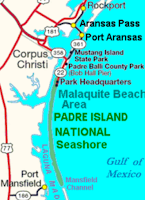There is nothing like going to the beach in December! Admittedly, it was a bit chilly, but we had no problem finding a place to park at the Gulf Coast's Mustang Island.
Personally, I find it a bit off-putting the way Texans make the beach their personal highway. Cars on beaches don't make sense to me. (Sorry Daytona, this goes for you too.) Beaches are a living ecosystem supporting a wild diversity of marine and maritime life. Unless, you drive cars on it all day- then the compacted sand can't support much of anything- other than beer cans and trash.
 |
| Enjoying Mustang Island's Beach all to ourselves! |
Mustang Island board of tourism would probably like me to remind you that this is the "Riviera of Texas." You can google around and find plenty of people enjoying these beaches in much warmer weather, but you wont find me there!
 |
| Shelly has coffee on the pier overlooking the water. |
We enjoyed ourselves immensely. The restaurant at the top of the Bob Hall Pier was open and served all of our favorite beverages along with a decent lunch. They had a few heaters running but the big over-head doors that serve as windows onto the water had to remain closed. It is best I am not distracted by birds during lunch, anyway.
 |
| Western Willet on parade. |
A very handsome shore bird was putting on a good show. This bird certainly looked like a Willet, but it seemed big to me. My enjoyment of nature always multiplies when I get to study the photos later. I learned that Texas' fall Willets are often Western Willets, Tringa semipalmata inornata and considerably larger than the Willets we see on the North and East Coasts. O'Brien, Crossley, and Karlson's The Shorebird Guide provided good commentary and photos on this topic. It is not a different species, but rather a subspecies of Willet, Tringa semipalmata.
 |
| Padre Island, Texas- miles and miles of blue skies and undeveloped sandhills. |
If you would like to know more about Whooping Crane conservation and the on-going battle to protect them from extinction, please click on the photo below to go to the International Crane Foundation website. Thank You.





No comments:
Post a Comment